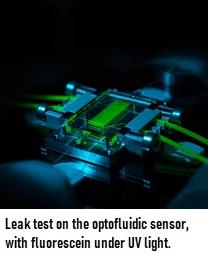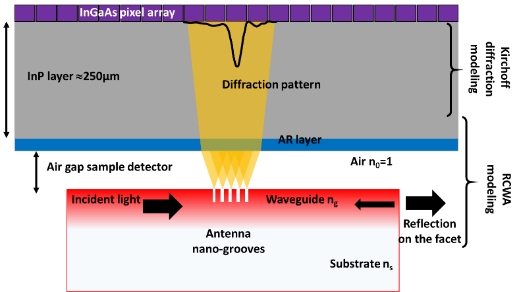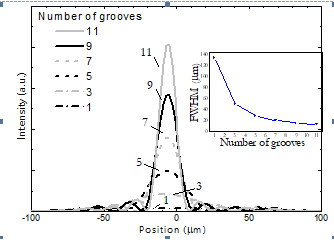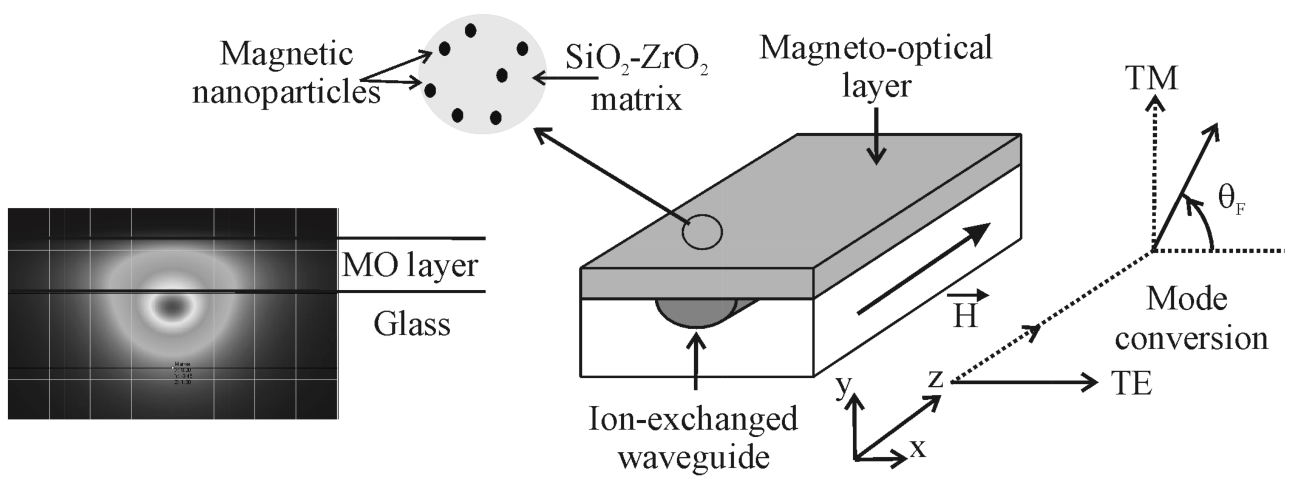Contact
Contexte et objectifs
La photonique intégrée est développée au CROMA depuis plus de 40 ans, sur une plateforme verre, unique en France. L’équipe PHOTO a acquis dans ce domaine des compétences reconnues internationalement allant de la conception, modélisation, fabrication jusqu’à la caractérisation. Cette technologie est étudiée par quelques rares laboratoires à l’échelle de l’Europe (Fraunhofer institute IZM, ORC Southampton, Helsinki University-Finland). Son intérêt s’illustre par un développement de produits industriels, par des entreprises telles que Teem Photonics, Corning, Schott Glass et Color-Chip. Cette technologie permet la réalisation de composants intégrés passifs grâce à des guides d’ondes réalisés par échange d’ions, dont les dimensions et indices de réfraction sont particulièrement adaptés au couplage avec les fibres optiques. Par ailleurs, l’utilisation de verres dopés aux terres rares permet également l’élaboration de dispositifs actifs tels que des amplificateurs optiques et des lasers.
Le verre est un matériau très intéressant en tant que plateforme optique du fait de ses caractéristiques optiques et mécaniques, mais également d’un point de vue du développement durable. La silice, principal composant du verre, est un matériau abondant sur terre assez peu soumis à des problèmes d’approvisionnement. Le verre possède une filière industrielle de recyclage déjà en place. De plus il présente des pertes diélectriques faibles dans les fréquences RF et est donc bien adapté en tant qu’interposeur pour des fonctions optoélectroniques à haute fréquence. Son excellente durabilité chimique nous a permis de développer des capteurs multimodaux compatibles avec des milieux biologiques ou des milieux extrêmement acides (capteurs pour le nucléaire). Par ailleurs, le verre possède des coefficients non-linéaires et d’absorption à deux photons extrêmement bas. Il est donc bien adapté à l’intégration hétérogène de matériaux présentant des propriétés optiques complémentaires. Dans ce but, nous avons développé des techniques d’adhérence moléculaire et d’amincissement de manière à intégrer des milieux à gain et/ou non-linéaires, des matériaux magnéto-optiques ou des cristaux pour les mémoires quantiques sur nos guides d’ondes.
Trois activités sont développées au sein du thème :
- Lasers
-
Laser pour la génération de signaux THz. Des techniques d’échange d’ions sont utilisées pour réaliser des guides optiques monomodes sur des verres co-dopés erbium-ytterbium, puis ces structures sont associées par adhérence moléculaire avec des réseaux de Bragg photo-inscrits dans des verres passifs, permettant de concevoir des lasers DFB continus fonctionnant dans la bande C (1550 nm). Ces dispositifs sont encapsulés, ce qui les protège mécaniquem
ent et les rend moins sensibles aux variations de température extérieure. Nous avons développé des puces optiques contenant plusieurs lasers émettant des longueurs d’onde différentes en vue de générer, à l’aide d’une photodiode rapide, des signaux radiofréquence par le battement optique entre deux raies. Nous avons ainsi démontré la génération de signaux de quelques dizaines de MHz jusqu’à 285GHz (cf. Figure 1). La très haute cohérence intrinsèque de chaque laser permet d’obtenir des signaux THz dont la largeur de raie est de l’ordre du kHz tout en étant peu sensible à la température de fonctionnement (dérive inférieure à 15MHz sur 15min sans régulation thermique), et ce sans système de contre réaction ou de stabilisation thermique. Le projet ANR PICOTE(2023-2027), piloté par l’équipe, vise à associer ces lasers avec des modulateurs en niobate de lithium, fabriqués par notre partenaire industriel Exail, afin de mettre en boîtier un dispositif multi-puces verre-LiNbO3 dédié aux communications haut débit THz (IEMN et IES).
Laser impulsionnels. En parallèle, une activité autour des lasers impulsionnels intégrés sur verre existe au laboratoire depuis une vingtaine d’années. Ils nécessitent d’intégrer un matériau absorbant saturable, qui permet le déclenchement des impulsions. Nos premiers travaux utilisaient un absorbant saturable organique (molécule de colorant associée à un polymère), qui a montré des limites en termes de tenue au flux optique et de durabilité. Ces dispositifs ont malgré tout donné d’excellents résultats puisqu’ils ont par exemple permis de mettre au point des sources à supercontinuum à base de lasers intégrés. Avec le projet ANR CRUMBLE (2022-2026), piloté au laboratoire, nous souhaitons mettre au point un nouveau matériau absorbant saturable permettant de dépasser les limitations rencontrées précédemment. La piste principale que nous explorons concerne un matériau sol-gel dopé par des nanocristaux de YAG:Cr4+ qui permettront un fonctionnement en régime Q-SWITCH. Le défi est ici de mettre en forme ce matériaux déjà utilisé en tant qu’absorbant saturable dans des cavités laser en optique de volume, sous forme de couche mince, tout en préservant ses propriétés optiques. L’intérêt du sol-gel en tant que matrice hôte est sa compatibilité avec le procédé d’échange d’ions, notamment en termes de budget thermique (collab. CROMA, LaHC, ICCF, Teem-Photonics).
Depuis 2023, des travaux sont également menés sur la réalisation de lasers à blocage de modes passif intégrés sur verre pour la génération d’impulsions ultra-brèves (sub-picosecondes). Nous étudions une nouvelle approche pour leur intégration sur puce grâce à l’hybridation de composants actifs (guides amplificateurs), passifs (miroir, multiplexeur, coupleur de sortie) et de l’absorbant saturable (à semiconducteur) sur un même substrat (collab. C2N).
Exemples de références :- Léo Hétier, Julien Poëtte, Lionel Bastard, Jean-François Roux, Pierre-Baptiste Vigneron, Jean-Emmanuel Broquin, "THz generation by beating of self-running Er-based ion-exchanged DFB lasers co-integrated on one single chip," Proc. SPIE 12424, Integrated Optics: Devices, Materials, and Technologies XXVII, 124240F (17 March 2023); https://doi.org/10.1117/12.2650510
- Capteurs photoniques
-
Détection de pollution dans les milieux aqueux. Un capteur innovant pour surveiller
la pollution de l’eau a été développé grâce à une collaboration académique (CROMA, IGE, G2Elab, CBSA, COBRA) et une thèse (2021-2024). Il repose sur la détection de la viabilité de bactéries sensibles à des polluants spécifiques. Une force de diélectrophorèse trie spatialement les bactéries mortes et vivantes, tandis qu’un guide photonique mesure les pertes de diffusion optiques en fonction du ratio bactéries mortes/vivantes, indiquant ainsi la présence de polluants (cf. figure 2). Un circuit microfluidique co-intégré gère le fluide. L’utilisation de bactéries sentinelles non OGM évite la nécessité de fonctionnalisation de surface, augmentant la durabilité et facilitant le nettoyage. Un prototype initial a validé le principe sur des microbilles de polystyrène, et des essais avec des bactéries E. coli ont confirmé le tri spatial et la détection optique. Ce capteur met à profit l’excellente compatibilité de la plateforme photonique sur verre avec les milieux aqueux et biologiques. Il s’intègre dans un projet de capteur environnemental multi-physique mené par les équipes DHREAMS et CROMA.
Détection de pollution atmosphérique. Dans le cadre du projet européen RAVEN, débuté en 2024 porté par l’Université Eastern Finland, un capteur de gaz sur verre est en cours de développement. Il utilise la détection par onde évanescente et les ondes de surface de Bloch. L’architecture repose sur une spirale intégrée sur verre (offrant faible perte optique et large bande passante) et un filtre diélectrique multicouche (sensibilité élevée et accordabilité en longueur d’onde). Ce projet découle de la chaire d’excellence Nokia attribuée à Jean-Emmanuel Broquin en 2021.
Mesure de l’oxygène dissous. Depuis 2016, une collaboration avec l’équipe FunSurf du LMGP a conduit à une thèse (2019-2023) sur un capteur d’oxygène dissous. Il repose sur des couches sol-gel dopées d’un luminophore à base de Rhuténium, dont la photoémission varie en fonction de l’oxygène. Les couches sont photosensibles et déposées sur un substrat en verre optique, on peut obtenir des guides d’onde avec des réseaux de diffraction, grâce à un simple procédé de photolithographie directe. CROMA a contribué à la modélisation et caractérisation des guides et coupleurs optiques, facilitant l’alignement des fibres d’excitation. Ce travail a permis d’améliorer l’efficacité du couplage lumineux tout en réduisant les contraintes d’alignement optique de la fibre transportant le signal d’excitat
ion à 450 nm.
Spectromètre intégré. Depuis une décennie, des travaux ont porté sur le développement de spectromètres SWIFTS à haute résolution. Une version pour le visible a été transférée à une start-up acquise par le groupe Merk. Les recherches actuelles visent à adapter le SWIFTS au proche et moyen infra-rouge, en collaboration avec l’IPAG, FEMTO/ST, le LaHC et l’Université de Salamanca. Un projet soutenu par larégion AURA et le Labex FOCUS travaille sur une version NIR sur puce en verre avec TEEM Photonics. Des nano-antennes ont été spécialement désignées et réalisées sur une puce en optique intégrée sur verre pour avoir pour la première fois un spectromètre SWIFTS monolithique sans optique de relais dans le NIR. L’objectif est d’utiliser cet instrument pour l’analyse laser et le développement de capteurs de gaz. La modélisation des antennes s’est appuyée sur un outil numérique A-DM-FFF, optimisant le calcul des coefficients de réflexion (cf. figure 3). Ces outils découlent du projet ANR ODISSEA (collab. CROMA, LNIO, SURYS), initialement dédié aux réseaux diffractants pour la sécurité visuelle. Ils ont également été utilisés pour modéliser des réseaux dédiés à la mesure de l’oxygène dissous ou aux applications Térahertz dans le projet AURA AUTHANTIC.
Exemples de références :- Myriam Bonduelle, Irene Heras, Alain Morand, Gwenn Ulliac, Roland Salut, Nadege Courjal, and Guillermo Martin, "Near IR stationary wave Fourier transform lambda meter in lithium niobate: multiplexing and improving optical sampling using spatially shifted nanogroove antenna," Appl. Opt. 60, D83-D92 (2021)
- Hybridations / Technologies émergentes
-
Développement technologiques - Hybridation. Dans l’objectif d’intégrer de nouvelles fonctions à la plateforme de photonique intégrée sur verre développée au laboratoire, des recherches sont menées sur le développement de structures hybrides combinant le verre à divers autres matériaux. Des collaborations avec ST Microelectronics et le CEA-LETI ont notamment mené au développement de dispositifs hybrides verre/silicium et III-V/silicium. Le projet IMPEQ, (IRGA -UGA) porté par le laboratoire, a permis d’initier une collaboration avec l’Institut Néel (équipe NPSC) pour réaliser des mémoires optiques quantiques exploitant un guide hybridant substrat de verre et couche mince d’un cristal d’Er:Y2SiO5. Ces travaux sont aujourd’hui poursuivis dans le cadre du projet ciblé QMemo du PEPR Quantique. Jean-Emmanuel Broquin a obtenu en 2020 la Chaire d’Excellence de la Fondation Nokia pour développer des amplificateurs optiques et des sources à supercontinuum grâce aux structures hybrides sur verre, en collaboration avec plusieurs universités finlandaises (Aalto, Tampere et University of Eastern Finland). En 2021, un nouveau MCF a rejoint l’équipe pour renforcer cette thématique. Depuis 2024, l’équipe participe également au projet Q-Loop de l’IRT Nanoelec, qui vise à développer des interposeurs optiques pour fonctionner à des températures cryogéniques, en collaboration avec le CEA-LETI et le C2N.
Photonique intégrée pour le calcul neuromorphique et la sécurité. La photonique intégrée offre des avantages
pour le développement de nouvelles architectures informatiques et de couches de sécurité. Ces deux applications bénéficient du grand nombre de degrés de liberté présents en photonique, des plateformes à faibles pertes de propagation, de larges bandes passantes ainsi que du mélange complexe des chemins de données optiques. Plusieurs projets explorent des solutions optimales pour des systèmes économes en énergie et sécurisés.
Le projet Horizon Europe NEUROPULS, coordonné par CROMA (15 partenaires au total), vise à développer un accélérateur photonique interfacé avec RISC-V en utilisant des matériaux à changement de phase pour des poids synaptiques sans perte (en inférence) et plastiques. Les nouvelles architectures d'accélérateurs que nous étudions conjointement avec U-GENT, HPE et POLITO seront protégées par un type spécifique de primitive de sécurité : les structures physiques non clonables (PUF), en cours de développement au laboratoire. Elles garantissent la sécurité de l’accélérateur en servant de racine de confiance, facilitant ainsi l’authentification, l’attestation logicielle et le chiffrement des données. Comparées à d’autres solutions PUF adaptées au domaine numérique, les PUFs photoniques promettent une plus grande résilience face aux attaques par modélisation ML ainsi qu’une meilleure efficacité énergétique. Un des principaux défis et de les rendre compatibles avec la filière CMOS. Nous nous intéressons également à leur développement pour des applications iOT.
Detection of plutonium (VI) in an optofluidic device

CROMA worked with the Marcoule CEA to create a novel optofluidic sensor, dedicated to probing fluids that are both chemically agressive and radioactive such as those involved in the reprocessing of spent nuclear fuel.
The device, entirely made on glass, is rugged enough to be exploited in a nuclearized glove box to perform absorption spectroscopy, thanks to optical waveguides made by ion-exchange on glass interacting with a fluidic micro-cuvette.
This allowed the first concentration measurement of plutonium (VI) in nitric acid in a microsystem containing only 20 µl of radioactive liquid. When compared to the 10 ml samples needed for standard measurements, this device paves the way to faster and cheaper analysis of spent nuclear fuel.
Contact: Davide BUCCI
Relevant publications : Microsensing of plutonium with a glass optofluidic device.
Optical Engineering, 2019 => https://hal.archives-ouvertes.fr/hal-02157782
Optical numerical tool development for scattering analysis of diffractive components and color generation
The light scattering from periodic structure is an important subject for different types of applications (Spectrometry, wavelength filter, photovoltaic structures …). For that, numerical modelization tools as RCWA (Rigorous Coupled Wave Analysis) or the DM (differential Method) are developed in our lab. RCWA is efficient for lamellar profiles but this is not the case for continuous profiles especially for TM polarization with grating composed of metal. The DM associated to the FFF has been demonstrated to be a solution. The development of these tools is used in this project to design novel color diffractive components for security application.

(Period of 0.5 µm, depth of 0.2 µm, nsup = 1, nmetal = 1.3 + j7.6, incident angle 30° and λ= 0.6328 µm).
Study performed by: Habib Mohamad (PhD), Alain Morand and Pierre Benech
Collaborations:- D. Macias and S. Blaize, INL, Troyes, France
- Mikael Renault, SURYS, Bussy-Saint-Georges, France
- Alain Morand
- Support: this research is supported by the French Research Agency (ANR) through the ANR PRCE project ODISSEA (ANR-16-CE39-0016)
- H. Mohamad, S. Es-Saïdi, A. Morand, P. Benech, D. Macias adn S. Blaize, « Fast Fourier Factorization : a powerful tool for the modelling of non-lamellar metallic gratings compared to the C-method », OWTNM in Malaga, 2019
- A. K. Gonzales-Alcade, R. Salas-Montiel, H. Mohamad, A. Morand, S. Blaize and D. Macias, "Optimization of all-dielectric structures for color generation", Applied optics 57 (14), pp. 3959-3967, 2018.
- H. Mohamad, A. Morand, S. Blaise, D. Macias, P. Benech, « Efficacité de la FFF sur la RCWA et la méthode différentielle appliquée à la diffraction d’un réseau métallique sinusoïdal », Journées Nationales d’Optique Guidée à Toulouse, 2018.- H. Mohamad, A. Morand, P. Benech, S. Blaise « La méthode différentielle associée à la FFF : de l’optique diffractive vers l’optique guidée », GDR Ondes à Marseille, juin 2019.
Nano-grooves scattering centers acting as antenna in integrated optics Fourier transform spectrometers
Stationary Wave Integrated Fourier Transform Spectrometers (SWIFTS) are based on the sampling of a stationary wave using nano-scattering centers on the surface of a channel waveguide. Single nano-scale scattering centers above the waveguide surface will radiate the sampled signal with wide angular distribution, which is not compatible with the buried detection area of infrared detectors, resulting in crosstalk between pixels. An implementation of multiple diffraction nano-grooves (antenna) for each sampling center is proposed as an alternative solution to improve directivity towards the detector pixel by narrowing the scattering angle of the extracted light. And its efficiency is demonstrated from both modelized and measured far field radiative patterns exhibiting a promising method to be used for future integrated IR-SWIFTS.
Study performed by: Irène Heras (Post-doc) and Alain MorandCollaborations:
- G. Martin, IPAG, Grenoble, France
- N. Courjal, FEMTO-ST, Besançon, France
Support: This research is supported by the French Research Agency (ANR-11-LABX-0013) and FP7 people Marie-Curie Actions (PCOFUND-GA-2013-609102)

Schematic 2D representation of the LN waveguide with a 5 FIB nano-grooves (100x500 nm section) antenna and the IR detector comprised of 128x128 pixel array with 20 µm pixel pitch

- Heras, G. Ulliac, E. Le Coarer, P. Benech, N. Courjal, G. Martin, "Improving the vertical radiation pattern issued from multiple nano-groove scattering centers acting as an antenna for future integrated optics Fourier transform spectrometers in the near IR", Optics Letters. 44(3), 2019.A. Morand, I.
- I. Heras, J. R. Vazquez de Aldana, A. Morand and G. Martin,. “High resolution and wideband integrated optics infrared stationary-wave spectrometer fabricated by ultrafast laser inscription”, Advances in optical and mechanical Technologies for telescopes and instrumentation III, Proceeding of SPIE Volume 10706, 2018.
- M. Bonduelle, G. Martin, A. Morand, G. Zhang, G. Cheng, C. D’amico and R.Stoian, « Laser Written Nano-Antenna and Waveguides devoted to Stationary Wave Sampling in Integrated Optic Spectrometers for the Near Infrared », CLEO Europe 2019 in Munich, poster, 2019
Magneto-optical mode converter on glass
The integration of magneto-optical materials to realize non-reciprocal functions is still a challenging target. Indeed, classical magneto-optical materials require an annealing temperature as high as 700°C, involving strong thermal budget constraints. In this framework, this study shows how it is possible to realize an efficient magneto-optical mode converter integrating a magnetic nanoparticles silica/zirconia composite with an ion-exchanged glass waveguide. Using a sol gel process, a silica/zirconia matrix is doped by magnetic nanoparticles (CoFe2O4) and coated on a glass substrate containing straight channel waveguides made by a silver/sodium ion exchange. The extremities of the guides were previously buried using electric field-assisted burial in order to facilitate light injection. Soft annealing and UV treatment, both compatible with the ion exchange process, have been implemented to finalize the magneto-optical film.
Collaborations:- Laboratoire Hubert Curien, Université Jean-Monnet
- Laboratoire PHENIX, Université Pierre et Marie Curie
Relevant articles :
- Full experimental determination of the optical and magneto-optical characteristics of a hybrid glass waveguide covered by a magnetic nanoparticles doped sol-gel layer
- Birefringence measurements in optical waveguides
- Efficient magneto-optical mode converter on glass




